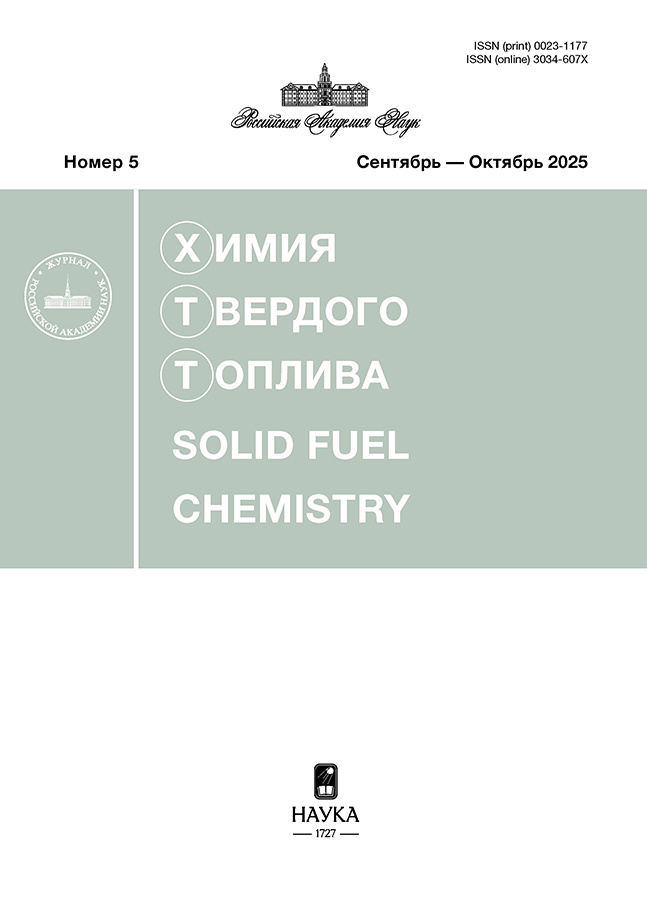Himiâ tverdogo topliva
ISSN(Print): 0023-1177
Media registration certificate: No. 0110273 dated 02/09/1993
Founder: Institute of Organic Chemistry named after. N.D. Zelinsky RAS, Russian Academy of Sciences
Editor-in-Chief: Lapidus Albert Lvovich
Number of issues per year: 6
Indexation: RISC, list of Higher Attestation Commissions, CrossRef, White List (level 2)
Ағымдағы шығарылым
№ 5 (2025)
Articles
FEATURES OF RHENUM DISTRIBUTION IN DICTYONEMA SHALES OF THE BALTIC BASIN (WITHIN THE LENINGRAD REGION)
Аннотация
The article presents the results of studies of the distribution of rhenium in black (dictyonema) shales of the Baltic basin, on Kaibolovo-Gostilitsy area, located in the Leningrad region. Rhenium contents exceeding the levels of minimum industrial concentrations in known types of complex ores have been determined. The distribution of rhenium in the organic and mineral parts of black shales has been studied. The distribution of rhenium in the dictyonema shale formation over the area and in the section of the shale-bearing stratum, and the conditions under which rhenium mineralization was formed, are described. The rhenium resources in the dictyonema shales of the Russian part of the Baltic basin should be considered as a new unconventional source of this valuable strategic metal.
 3-10
3-10


Precious Metals in Black Shales of the Baltic Basin (Leningrad Region)
Аннотация
This article presents the results of studies on the noble metal contents of the Paleozoic dictyonema shales of the Baltic sedimentary basin. On the territory of the studied Kaibolovo–Gostilitsy prospecting area, high, up to potentially industrial, concentrations of noble platinum group metals (PGMs), comparable with the concentrations in sedimentary ore types taken into account by the State Balance of Mineral Reserves of the Russian Federation, have been confirmed with a large factual material (more than 600 shale samples). Increased gold and silver contents have also been noted. Palladium predominated in the composition of platinum group metals. The article presents the identified features of the PGM distribution over the area and in the section of the shale-bearing sedimentary strata. Precious metals in the dictyonema shales of the Baltic basin are distributed in the shales in the following forms: in terrigenous scattered finely dispersed native minerals (forms), in impurities in sulfide minerals (mainly in pyrite), and in species localized in the organic matter (Ag and partly Au). The conditions of formation of precious metal mineralization in the dictyonema shales have been reconstructed. The source of precious metals were rocks of the provenance area – the Baltic Shield – and seawater of the ancient sedimentation area, a supplier of a number of rare metals deposited on the geochemical reducing barrier of the dictyonema shales. Increased and stable concentrations of precious metals in combination with large-scale (billions of tons) geological resources of the dictyonema shales indicated the possible presence of a large unconventional mineral resource base of precious metals in the Baltic region of Russia.
 11-21
11-21


Structural Features of Coals and Their Proneness to Spontaneous Combustion
Аннотация
The paper presents the results of an assessment of the influence of coals’ structural features on their proneness to spontaneous combustion. 15 samples of hard coals and anthracite from different deposits of the Russian Federation were used as objects of of study. Based on the deconvolution of coal vitrinite raman spectra, a structural index characterizing the ratio between amorphous and crystallite forms of carbon compounds has been identified. It is noted that this index differs significantly for coals with a close stage of metamorphism. For the studied coals, the activity was determined for two types of cites that are differing in the rate of deactivation when interacting with ozone. The activity of cites of the first type (with a higher deactivation rate when interacting with ozone) grows with an increase in the proportion of crystalline carbon in the coals’ vitrinite, and the activity of cites of the second type (with a low rate of deactivation) generally decreases. The kinetic parameters of the combustion of coals (ignition temperature and activation energy) were estimated according to their thermogravimetric analysis in the air environment. It is shown that with an increase in the proportion of amorphous carbon compounds in vitrinite of coals, both the ignition temperature and the activation energy of coal combustion decrease, which altogether leads to an increase of a risk of spontaneous combustion.
 22-32
22-32


THE EFFECT OF TEATMENT OF FUSENIZED COAL WITH GASEOUS MEDIA ON THE INITIAL STAGES OF OXIDATION IN AN AIR ENVIRONMENT
Аннотация
The peculiarities of the change in the composition of SS grade coal prone to spontaneous combustion after its treatment in an environment of gases of various chemical activity (nitrogen, air, carbon dioxide) are investigated. The effect of gases on changes in the chemical composition of the coal surface and the adsorption capacity to oxygen during low-temperature oxidation of coal in the air has been established. EPR spectroscopy data indicate a re-combination of free radicals at the initial stages of coal oxidation, followed by an intensification of their formation when coal samples are exposed to air. Analysis of changes in the rate of oxygen absorption and the composition of the gas phase indicates the highest sorption activity to oxygen of a coal sample treated in an inert nitrogen environment. The crushing of coal in the air atmosphere leads to the primary oxidation of the native outer surface and a decrease in the sorption capacity to oxygen at the initial stage of its determination. The adsorption of carbon dioxide on an accessible coal surface is accompanied by a transformation of its functional composition and, thereby, a slowdown in the initial stages of oxidation.
 33-42
33-42


Determination of chlorin-containing organic compounds in the thermal processing resin of oil shale from the Perelyubskoye deposit
Аннотация
The distribution of organic chlorine in the fractions of semicoking resin of the oil shale from the Perelyubskoye deposit was studied. The highest concentrations of organochlorine compounds were determined in the resin fractions with boiling ranges of 100–120, 140–160, 240–260, and 280–320°C. Based on the experimental data, possible ways of further use of shale resin were proposed.
 43-47
43-47











